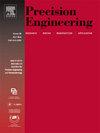Experimental study on in-situ laser-assisted diamond turning of single crystal germanium
IF 3.5
2区 工程技术
Q2 ENGINEERING, MANUFACTURING
Precision Engineering-Journal of the International Societies for Precision Engineering and Nanotechnology
Pub Date : 2025-03-28
DOI:10.1016/j.precisioneng.2025.03.032
引用次数: 0
Abstract
For typical optical crystals like silicon and germanium, conventional ultra-precision machining ensures high machining quality but significantly reduces efficiency. Consequently, in-situ laser-assisted turning has emerged as a viable alternative. This study focuses on the single crystal germanium (111) surface and establishes a temperature-dependent model for calculating the critical cutting thickness of ductile-to-brittle transition. Orthogonal experiments were conducted on in-situ laser-assisted turning, followed by variance analysis, signal-to-noise ratio analysis, and mean analysis of the post-machining surface roughness. The contribution of each machining parameter to reducing surface roughness is as follows: rake angle > laser power > spindle speed > feed rate > cutting depth. The optimized parameter combination identified is: rake angle of −35°, laser power of 10 W, spindle speed of 2000 r/min, feed rate of 1 μm/r, and cutting depth of 1 μm. Machining with these parameters reduced surface roughness by 22.4 % compared to conventional machining under the same conditions, resulting in a surface free of fractures and pits.

原位激光辅助金刚石车削单晶锗的实验研究
对于硅、锗等典型光学晶体,传统的超精密加工虽然保证了较高的加工质量,但却大大降低了加工效率。因此,原位激光辅助车削已成为一种可行的替代方案。本研究以单晶锗(111)表面为研究对象,建立了计算韧脆转变临界切削厚度的温度依赖模型。对原位激光辅助车削进行正交试验,进行方差分析、信噪比分析和加工后表面粗糙度均值分析。各加工参数对减小表面粗糙度的贡献如下:前倾角>;激光功率>;主轴转速>;进给量>;切削深度。确定的优化参数组合为:前倾角为−35°,激光功率为10 W,主轴转速为2000 r/min,进给速度为1 μm/r,切割深度为1 μm。与相同条件下的常规加工相比,使用这些参数加工的表面粗糙度降低了22.4%,从而使表面没有断裂和凹坑。
本文章由计算机程序翻译,如有差异,请以英文原文为准。
求助全文
约1分钟内获得全文
求助全文
来源期刊
CiteScore
7.40
自引率
5.60%
发文量
177
审稿时长
46 days
期刊介绍:
Precision Engineering - Journal of the International Societies for Precision Engineering and Nanotechnology is devoted to the multidisciplinary study and practice of high accuracy engineering, metrology, and manufacturing. The journal takes an integrated approach to all subjects related to research, design, manufacture, performance validation, and application of high precision machines, instruments, and components, including fundamental and applied research and development in manufacturing processes, fabrication technology, and advanced measurement science. The scope includes precision-engineered systems and supporting metrology over the full range of length scales, from atom-based nanotechnology and advanced lithographic technology to large-scale systems, including optical and radio telescopes and macrometrology.

 求助内容:
求助内容: 应助结果提醒方式:
应助结果提醒方式:


